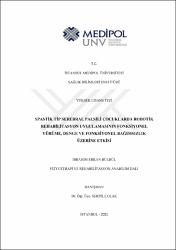| dc.contributor.advisor | Çolak, Serpil | |
| dc.contributor.author | Bülbül, İbrahim Erkan | |
| dc.date.accessioned | 2021-09-08T09:30:13Z | |
| dc.date.available | 2021-09-08T09:30:13Z | |
| dc.date.issued | 2021 | en_US |
| dc.date.submitted | 2021-01-06 | |
| dc.identifier.citation | Bülbül, İ. E. (2021). Spastik tip serebral palsili çocuklarda robotik rehabilitasyon uygulamasının fonksiyonel yürüme, denge ve fonksiyonel bağımsızlık üzerine etkisi. (Yayınlanmamış yüksek lisans tezi). İstanbul Medipol Üniversitesi Sağlık Bilimleri Enstitüsü, İstanbul. | en_US |
| dc.identifier.uri | https://hdl.handle.net/20.500.12511/8042 | |
| dc.description.abstract | Bu çalışmanın amacı spastik tip serebral palsili çocuklarda alt ekstremite robotik rehabilitasyon uygulamasının fonksiyonel bağımsızlık, denge ve fonksiyonel yürüme üzerine etkilerini araştırmaktır. İstanbul Özel Yeni Huzur Tıp Merkezi Fizik Tedavi ve Rehabilitasyon Ünitesi'ne başvuran spastik tip serebral palsi tanılı, GMFCS'e göre seviye I-III arasında olan 30 hasta randomize iki grup halinde araştırmaya alındı. Bir gruba (n=15) konvansiyonel fizyoterapi uygulanırken diğer gruba (n=15) robotik rehabilitasyon uygulandı. Her iki grup da 5 hafta süreyle haftada 45 dakikalık 3 seans halinde tedaviye katıldı. Robotik rehabilitasyonda RoboGait® alt ekstremite yürüme robotu kullanıldı. Tedavi başlangıcı ve sonunda hastalar Pediatrik Fonksiyonel Bağımsızlık Ölçütü (PFBÖ) (WeeFIM), Pediatrik Denge Ölçeği (PDÖ) ve Gillette Fonksiyonel Yürüme Değerlendirme Anketi ile değerlendirildi. Her iki grupta da tüm son ölçümlerde istatistiksel olarak anlamlı gelişme saptandı (p=0,001, p<0,01) fakat gruplar arasında hiçbir ölçümde anlamlı fark bulunmadı (p>0,05). Çalışmamızın sonuçları hem konvansiyonel fizyoterapinin hem de robotik rehabilitasyonun fonksiyonel bağımsızlık, denge ve fonksiyonel yürüme üzerine olumlu etkileri olduğunu göstermiştir. Konvansiyonel fizyoterapiye karşı robotik rehabilitasyonun üstünlüğü gözlemlenmemiştir. Elde edilen bu sonuçlar her iki yöntemin de serebral palsi tedavisinde kullanılabileceğine kanıt sağlamaktadır. Robotik rehabilitasyon uygulamasının tedavi programına eklenmesinin fizyoterapistin iş yükünü azaltabileceğinden ve hastaya yeni bir motivasyon oluşturabileceğinden faydalı olduğunu düşünmekteyiz. | en_US |
| dc.description.abstract | The aim of this study is to investigate the effects of lower extremity robotic rehabilitation on functional independence, balance and functional walking in children with spastic type cerebral palsy. Thirty patients with a diagnosis of spastic type cerebral palsy who applied to Istanbul Private Yeni Huzur Medical Center Physical Therapy and Rehabilitation Unit and who were between level I- III according to GMFCS were included in the study in two randomized groups. While conventional physiotherapy was applied to one group (n = 15), robotic rehabilitation was applied to the other group (n = 15). Both groups participated in the treatment in 3 sessions of 45 minutes per week for 5 weeks. Brand name RoboGait®, lower extremity walking robot, was used in robotic rehabilitation. Patients were evaluated with Independence Measure for Children (WeeFIM), the Pediatric Balance Scale (PBS) and the Gillette Functional Gait Assessment Questionnaire at the beginning and at the end of the treatment. A statistically significant improvement was found in all final measurements in both groups individually (p = 0.001, p <0.01), but no significant difference was found in any measurements among groups (p> 0.05). The results of our study showed that both conventional physiotherapy and robotic rehabilitation have beneficial effects on functional independence, balance and functional walking. The superiority of robotic rehabilitation over conventional physiotherapy has not been observed. As a result, we think that both methods can be used in the treatment of cerebral palsy, and adding the robotic rehabilitation application to the treatment program is valuable as it may reduce the workload of the physiotherapist and create a new motivation for the patient. | en_US |
| dc.language.iso | tur | en_US |
| dc.publisher | İstanbul Medipol Üniversitesi Sağlık Bilimleri Enstitüsü | en_US |
| dc.rights | info:eu-repo/semantics/openAccess | en_US |
| dc.subject | Denge | en_US |
| dc.subject | Fonksiyonel Bağımsızlık | en_US |
| dc.subject | Fonksiyonel Yürüme | en_US |
| dc.subject | Robotik Rehabilitasyon | en_US |
| dc.subject | Serebral Palsi | en_US |
| dc.subject | Balance | en_US |
| dc.subject | Functional Independence | en_US |
| dc.subject | Functional Gait | en_US |
| dc.subject | Robotic Rehabilitation | en_US |
| dc.subject | Cerebral Palsy | en_US |
| dc.title | Spastik tip serebral palsili çocuklarda robotik rehabilitasyon uygulamasının fonksiyonel yürüme, denge ve fonksiyonel bağımsızlık üzerine etkisi | en_US |
| dc.title.alternative | Effects of robotic rehabilitation application on functional walking, balance and functional independence in children with spastic TYPE cerebral palsy | en_US |
| dc.type | masterThesis | en_US |
| dc.department | İstanbul Medipol Üniversitesi, Sağlık Bilimleri Enstitüsü, Fizyoterapi ve Rehabilitasyon Ana Bilim Dalı | en_US |
| dc.relation.publicationcategory | Tez | en_US |


















